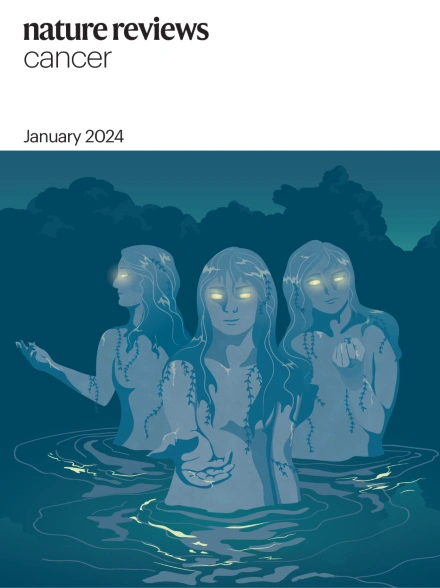Stemness in solid malignancies: coping with immune attack
IF 66.8
1区 医学
Q1 ONCOLOGY
引用次数: 0
Abstract
Immunotherapy has become a key new pillar of cancer treatment, and this has sparked interest in understanding mechanisms of cancer immune evasion. It has long been appreciated that cancers are constituted by heterogeneous populations of tumour cells. This feature is often fuelled by specialized cells that have molecular programs resembling tissue stem cells. Although these cancer stem cells (CSCs) have capacity for unlimited self-renewal and differentiation, it is increasingly evident that some CSCs are capable of achieving remarkable immune resistance. Given that most immunotherapy regiments have overlooked CSC-specific immune-evasive mechanisms, many current treatment strategies often lead to cancer relapse. This Review focuses on advancements in understanding how CSCs in solid tumours achieve their unique immune-evasive properties, enabling them to drive tumour regrowth. Moreover, as cancers often arise from tissue stem cells that acquired oncogenic mutations, we discuss how tissue stem cells undergoing malignant transformation activate intrinsic immune-evasive mechanisms and establish close interactions with suppressive immune cells to escape immune surveillance. In addition, we summarize how in advanced disease stages, CSCs often hijack features of normal stem cells to resist antitumour immunity. Finally, we provide insights in how to design a new generation of cancer immunotherapies to ensure elimination of CSCs. Immunotherapy shows promise in treating cancers by engineering T cells or using antibodies to activate them. However, cancer stem cells (CSCs) resist immunotherapies and drive cancer relapse. In this Review, Agudo and Miao highlight the mechanisms through which normal stem cells and CSCs in solid tumours achieve immune resistance, offering insights for the development of more effective cancer treatments.


实体恶性肿瘤中的干细胞:应对免疫攻击
免疫疗法已成为癌症治疗的一个新的关键支柱,这引发了人们对癌症免疫逃避机制的兴趣。人们早就意识到,癌症是由异质的肿瘤细胞群构成的。具有类似组织干细胞分子程序的特化细胞通常会助长这一特征。虽然这些癌症干细胞(CSCs)具有无限自我更新和分化的能力,但越来越明显的是,一些癌症干细胞能够获得显著的免疫抵抗力。由于大多数免疫疗法方案忽视了CSC特异性免疫侵袭机制,目前的许多治疗策略往往导致癌症复发。本综述将重点介绍在了解实体瘤中的 CSC 如何实现其独特的免疫侵袭特性方面取得的进展,从而使它们能够推动肿瘤的再生。此外,由于癌症通常来源于获得致癌突变的组织干细胞,我们将讨论发生恶性转化的组织干细胞如何激活内在的免疫侵袭机制,并与抑制性免疫细胞建立密切的相互作用,以逃避免疫监视。此外,我们还总结了在疾病晚期,癌干细胞如何经常劫持正常干细胞的特征来抵抗抗肿瘤免疫。最后,我们就如何设计新一代癌症免疫疗法以确保消灭癌干细胞提出了见解。
本文章由计算机程序翻译,如有差异,请以英文原文为准。
求助全文
约1分钟内获得全文
求助全文
来源期刊

Nature Reviews Cancer
医学-肿瘤学
CiteScore
111.90
自引率
0.40%
发文量
97
审稿时长
6-12 weeks
期刊介绍:
Nature Reviews Cancer, a part of the Nature Reviews portfolio of journals, aims to be the premier source of reviews and commentaries for the scientific communities it serves. The correct abbreviation for abstracting and indexing purposes is Nat. Rev. Cancer. The international standard serial numbers (ISSN) for Nature Reviews Cancer are 1474-175X (print) and 1474-1768 (online). Unlike other journals, Nature Reviews Cancer does not have an external editorial board. Instead, all editorial decisions are made by a team of full-time professional editors who are PhD-level scientists. The journal publishes Research Highlights, Comments, Reviews, and Perspectives relevant to cancer researchers, ensuring that the articles reach the widest possible audience due to their broad scope.
 求助内容:
求助内容: 应助结果提醒方式:
应助结果提醒方式:


